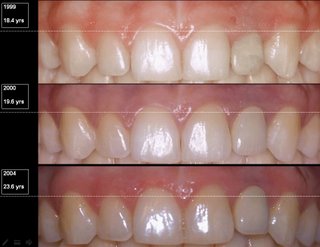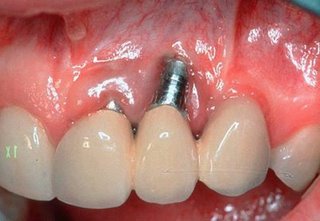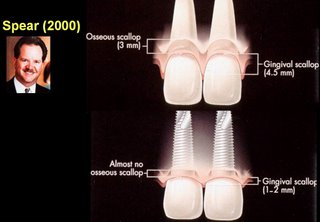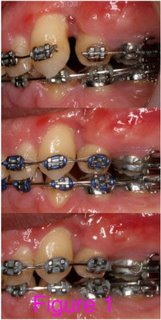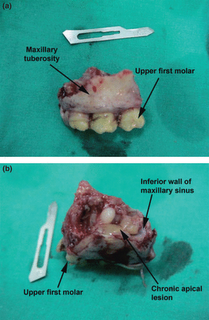What Happens if you swallow a Partial Denture (Gum Stripper)
Watch this real life video
How to Create Natural looking Smile ?

When it comes to restoring the mouth with porcelain in order to improve the aesthetics, the PLVs are one of the most conservative and aesthetic techniques that we can apply. The longevity of the veneers are quite long and durable especially if the right indications are chosen and the correct techniques are applied. Download to see Full technique
Dentists in India at Risk of Death from Hepatitis
MUMBAI: The 43 deaths in Modasa town of Gujarat's Sabarkantha district over the last fortnight due to hepatitis B underlines how widespread this viral infection really is. "It is one of the biggest public health challenges,'' said gastroenterologist Dr D N Amarapurkar of Bombay Hospital. Statistics bear this out: around 45 million Indians carry the deadly virus that can lead to liver failure and even cancer. "Around 30% of this patient pool would be seriously affected while the rest would carry on as though they are not affected,'' he added. "Mumbai is not a high-incidence zone, yet two out of 100 Mumbaikars carries the virus,'' said Dr Samir Shah, gastroenterologist from Jaslok Hospital. HIGHLY INFECTIOUS Hepatitis B is a viral infection of the liver, causing jaundice. It is transmitted through blood, body fluids and use of infected syringes among drug-abusers. "The virus can be transmitted even from a razor in a barber shop that has a drop of blood from an infected person. Infected children hurt while playing in the grounds can spread the virus,'' said Dr Amarapurkar. In Modasa, the Union health ministry believes that reusing of syringes and needles led to the outbreak.
There is ever-present danger of Hepatitis B transmission in dentistry if, i) dental personnel are not vaccinated and ii) vaccinated but with inadequate sero- conversion, Read How dentist can be saved from Hepatitis
Credit card as flossing tool ?
Dentists and periodontists everywhere have been horrified to learn poker decks do double duty as floss, a seamstress turns to her sewing thread, or needle, to remove the midday snack, and office workers turn pencils, paper clips or car keys into it'll-do-for-now floss. It's just not good dental practice.
"Improper tools can actually contribute to, or accelerate recession or abrasion [of the gums]. People actually chew off their fingernails and use them as floss," says dentist Gregg Liberatore. "Abrasion can also cause damage to the enamel or damage to the root surface." Full Release
Anger can kill you !
Anger and other strong emotions can trigger potentially deadly heart rhythms in certain vulnerable people, U.S. researchers. "It's definitely been shown in all different ways that when you put a whole population under a stressor that sudden death will increase," said Dr. Rachel Lampert of Yale University in New Haven, Connecticut, whose study appears in the Journal of the American College of Cardiology.
"Our study starts to look at how does this really affect the electrical system of the heart," Lampert said. Full News
Time to bid Good bye to Dentures,
Scientists believe they have found a way to grow teeth in the laboratory, a discovery that could put an end to fillings and dentures.
The US team from Oregon have located the gene responsible for the growth of enamel, the hard outer layer of teeth which cannot grow back naturally.
Other scientists are already growing the inner parts of teeth in animals - but they have no hard enamel coatings.
Dr Kioussi said: "A lot of work would still be needed to bring this to human applications, but it should work. It could be really cool, a whole new approach to dental health."
Paul Sharpe, an expert on tooth development at the Dental Institute at King's College London, said: "If you could find some way of growing ameloblasts that make enamel, you could find a way to repair teeth. Full Report from BBC
Prenatal vitamin D linked to dental health of kids
By maintaining adequate vitamin D levels during pregnancy, mothers may be protecting their babies against early tooth decay in childhood, according a study reported Friday at the International Association for Dental Research meeting in Toronto, Canada.
Dr. Robert Schroth from the University of Manitoba reported that mothers of children who developed cavities at an early age had significantly lower vitamin D levels during pregnancy than those whose children were cavity-free. Full News
Scientists Discover Why Teeth Form In A Single Row And How Each Tooth Signals The Next To Start Growing
A system of opposing genetic forces determines why mammals develop a single row of teeth, while sharks sport several, according to a study published today in the journal Science. When completely understood, the genetic program described in the study may help guide efforts to re-grow missing teeth and prevent cleft palate, one of the most common birth defects.
Gene expression is the process by which information stored in genes is converted into proteins that make up the body's structures and carry its messages. As the baby's face takes shape in the womb, the development of teeth and palate are tightly controlled in space and time by gene expression. Related abnormalities result in the development of teeth outside of the normal row, missing teeth and cleft palate, and the new insights suggest ways to combat these malformations. Full News
Hospitals may be dangerous for you
This news from Newzealand, What is happening in India ?
Adverse events in the country's hospitals last year included patients falling from operating tables, a surgical drape left inside a patient after surgery and all of a patient's teeth being mistakenly removed. Full paper
Watch this real life video
How to Create Natural looking Smile ?

When it comes to restoring the mouth with porcelain in order to improve the aesthetics, the PLVs are one of the most conservative and aesthetic techniques that we can apply. The longevity of the veneers are quite long and durable especially if the right indications are chosen and the correct techniques are applied. Download to see Full technique
Dentists in India at Risk of Death from Hepatitis
MUMBAI: The 43 deaths in Modasa town of Gujarat's Sabarkantha district over the last fortnight due to hepatitis B underlines how widespread this viral infection really is. "It is one of the biggest public health challenges,'' said gastroenterologist Dr D N Amarapurkar of Bombay Hospital. Statistics bear this out: around 45 million Indians carry the deadly virus that can lead to liver failure and even cancer. "Around 30% of this patient pool would be seriously affected while the rest would carry on as though they are not affected,'' he added. "Mumbai is not a high-incidence zone, yet two out of 100 Mumbaikars carries the virus,'' said Dr Samir Shah, gastroenterologist from Jaslok Hospital. HIGHLY INFECTIOUS Hepatitis B is a viral infection of the liver, causing jaundice. It is transmitted through blood, body fluids and use of infected syringes among drug-abusers. "The virus can be transmitted even from a razor in a barber shop that has a drop of blood from an infected person. Infected children hurt while playing in the grounds can spread the virus,'' said Dr Amarapurkar. In Modasa, the Union health ministry believes that reusing of syringes and needles led to the outbreak.
There is ever-present danger of Hepatitis B transmission in dentistry if, i) dental personnel are not vaccinated and ii) vaccinated but with inadequate sero- conversion, Read How dentist can be saved from Hepatitis
Credit card as flossing tool ?
Dentists and periodontists everywhere have been horrified to learn poker decks do double duty as floss, a seamstress turns to her sewing thread, or needle, to remove the midday snack, and office workers turn pencils, paper clips or car keys into it'll-do-for-now floss. It's just not good dental practice.
"Improper tools can actually contribute to, or accelerate recession or abrasion [of the gums]. People actually chew off their fingernails and use them as floss," says dentist Gregg Liberatore. "Abrasion can also cause damage to the enamel or damage to the root surface." Full Release
Anger can kill you !
Anger and other strong emotions can trigger potentially deadly heart rhythms in certain vulnerable people, U.S. researchers. "It's definitely been shown in all different ways that when you put a whole population under a stressor that sudden death will increase," said Dr. Rachel Lampert of Yale University in New Haven, Connecticut, whose study appears in the Journal of the American College of Cardiology.
"Our study starts to look at how does this really affect the electrical system of the heart," Lampert said. Full News
Time to bid Good bye to Dentures,
Scientists believe they have found a way to grow teeth in the laboratory, a discovery that could put an end to fillings and dentures.
The US team from Oregon have located the gene responsible for the growth of enamel, the hard outer layer of teeth which cannot grow back naturally.
Other scientists are already growing the inner parts of teeth in animals - but they have no hard enamel coatings.
Dr Kioussi said: "A lot of work would still be needed to bring this to human applications, but it should work. It could be really cool, a whole new approach to dental health."
Paul Sharpe, an expert on tooth development at the Dental Institute at King's College London, said: "If you could find some way of growing ameloblasts that make enamel, you could find a way to repair teeth. Full Report from BBC
Prenatal vitamin D linked to dental health of kids
By maintaining adequate vitamin D levels during pregnancy, mothers may be protecting their babies against early tooth decay in childhood, according a study reported Friday at the International Association for Dental Research meeting in Toronto, Canada.
Dr. Robert Schroth from the University of Manitoba reported that mothers of children who developed cavities at an early age had significantly lower vitamin D levels during pregnancy than those whose children were cavity-free. Full News
Scientists Discover Why Teeth Form In A Single Row And How Each Tooth Signals The Next To Start Growing
A system of opposing genetic forces determines why mammals develop a single row of teeth, while sharks sport several, according to a study published today in the journal Science. When completely understood, the genetic program described in the study may help guide efforts to re-grow missing teeth and prevent cleft palate, one of the most common birth defects.
Gene expression is the process by which information stored in genes is converted into proteins that make up the body's structures and carry its messages. As the baby's face takes shape in the womb, the development of teeth and palate are tightly controlled in space and time by gene expression. Related abnormalities result in the development of teeth outside of the normal row, missing teeth and cleft palate, and the new insights suggest ways to combat these malformations. Full News
Hospitals may be dangerous for you
This news from Newzealand, What is happening in India ?
Adverse events in the country's hospitals last year included patients falling from operating tables, a surgical drape left inside a patient after surgery and all of a patient's teeth being mistakenly removed. Full paper

